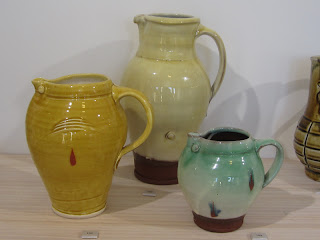This has been lifted from Wikipedia after I arrived there from Stumble Upon, this is something for the bored potter searching for new ideas to think about!
So relevant to current issues! Help prevent binge drinking. (Or heavy handed pourers.)
Pythagorean cup
From Wikipedia, the free encyclopedia
(Redirected from Pythagoras cup)
| This article does not cite any references or sources. Please help improve this article by adding citations to reliable sources. Unsourced material may be challenged and removed. (February 2012) |
A Pythagorean cup (also known as a Pythagoras cup, a Greedy Cup or a Tantalus cup) is a form ofdrinking cup which forces its user to imbibe only in moderation. Credited to Pythagoras of Samos, it allows the user to fill the cup with wine up to a certain level. If the user fills the cup only up to that level he may enjoy his drink in peace. If he exhibits gluttony, however, the cup spills its entire contents out the bottom (the intention being: onto the lap of the immodest drinker).
Contents[hide] |
[edit]Form and function
A Pythagorean cup looks like a normal drinking cup, except that the bowl has a central column in it – giving it a shape like a Bundt pan in the center of the cup. The central column of the bowl is positioned directly over the stem of the cup and over the hole at the bottom of the stem. A small, open pipe runs from this hole almost to the top of the central column, where there is an open chamber. The chamber is connected by a second pipe to the bottom of the central column, where a hole in the column exposes the pipe to (the contents of) the bowl of the cup.
When the cup is filled, liquid rises through the second pipe up to the chamber at the top of the central column, following Pascal's principle of communicating vessels. As long as the level of the liquid does not rise beyond the level of the chamber, the cup functions as normal. If the level rises further however, the liquid spills through the chamber into the first pipe and out the bottom. Hydrostatic pressure then creates a siphonthrough the central column causing the entire contents of the cup to be emptied through the hole at the bottom of the stem. Modern toilets operate on the same principle: when the water level in the bowl rises high enough, a siphon is created, flushing the toilet.
[edit]Common occurrences
The Pythagorean cup is credited as an invention to Pythagoras. For this reason, it is sold often on the Greek island of Samos as a touristsouvenir, sometimes with accompanying information, such as: "Tradition says Pythagoras, during water supply works in Samos around 530 BC moderated the workers' wine drinking by inventing the 'fair cup'. When the wine surpasses the line, the cup totally empties, so the greedy one is punished." Whether there is any basis to this historical assertion is unknown. However, water supply was evidently a problem in Pythagoras' time in Samos, as demonstrated by the 1,036 m (3,399 ft) Tunnel of Eupalinos that the ruler Polycrates had dug through rock to serve as an aqueductbringing water to the city.
Hero of Alexandria (c. 10–70 AD) used Pythagorean cups as hydraulic components in his robotic systems.
It is also sold in some toy stores as a practical joke gift.
[edit]See also
- Dribble glass
- Fuddling cup
- Puzzle jug
- Heron's fountain
- Soxhlet extractor, which uses the same mechanism.














































